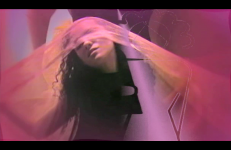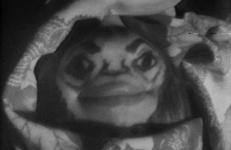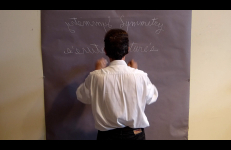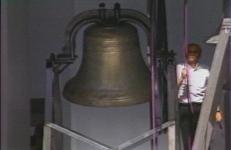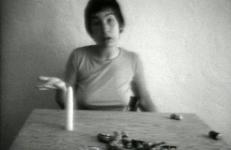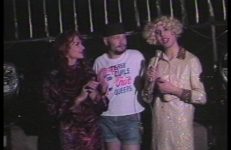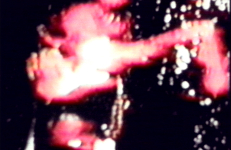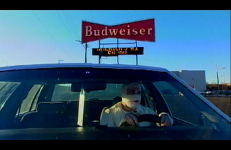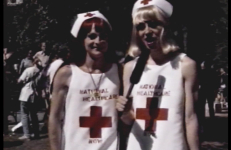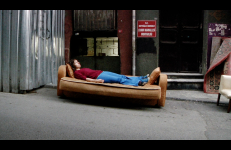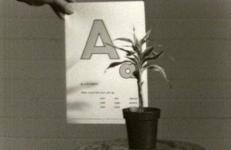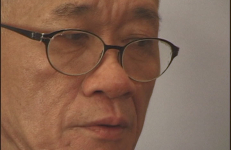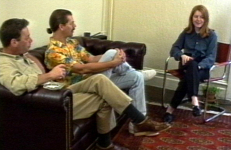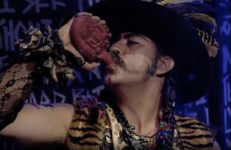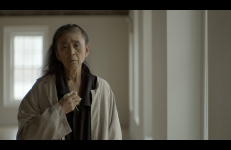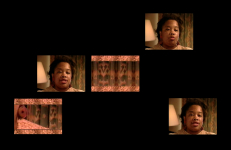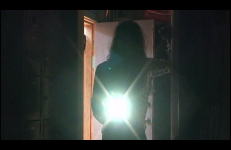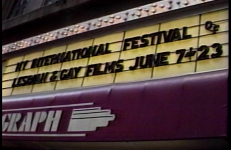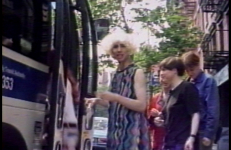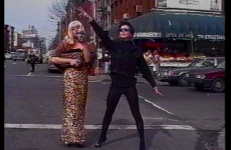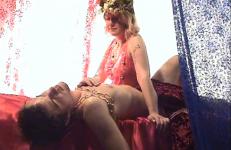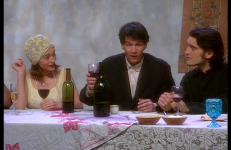Taste the delicious colors of "SWEET NOTHINGS" and observe the dice of desire being tossed on a gambler’s bed like yesterday’s candy. See tomorrow’s chocolate bunny melt into a brown puddle and feel a sticky, rainbow colored lolly-pop thats stuck to six feet of skin that secrets pent up passions... It’s all here for you to eat and is guaranteed to fatten your eyes!!
Performance
Nancy Cain interviews an upside down chin face about Women's Liberation, asking "Where do you stand on the subject?" The chin face professes to be happy with her lot, and says she enjoys living alone with her cat.
This video was shot in the Prince Street, New York loft/studio used by the Videofreex.
As the artist writes on a paper pinned to the wall in chalk, the left hand writes a mirror image of the right hand. The text reads "Symmetry is nature's way of seeing itself. P Kos 2004-2016"
Twelve church bells are rung daily for 30 days in a sculptural setting at the Capp Street Project in San Francisco. Ringers progress from practice sessions on beer bottles to a full-scale ring.
This piece was shot using a combination of 3/4" U-matic video plus Hi8 video.
This title is also available on Sympathetic Vibrations: The Videoworks of Paul Kos.
"I made Take Off in my studio apartment on Myra Avenue during my second year living in Los Angeles. As a member of the Feminist Studio Workshop, I was writing an essay at the time comparing male artists’ representations of their sexuality with female artists’. Vito Acconci was my model for a male perspective. I had been captivated by his videotapes; particularly Undertone, where he was supposed to be masturbating while seated at a table. The videotape was my ultimate response and commentary on Acconci as well as an expression of my own sexuality."
— Susan Mogul
In Takeover of the Empire State Building, Brenda and Glennda visit the top of the Empire State Building as it is lit up in lavender for Gay Pride. They interview both tourists visiting the building, and activists who have come to see the lights. Ultimately, they question whether this gesture is adequate, or if there is still a way to go until equality is achieved.
Talent Show satirizes music videos, while exploring sexual development in the age of the spectacle. The images in Talent Show are from the same found footage as Performance. The young boys lip-synch to a bubble gum rock song as they attempt to publicly assert their new-found sexual power. This display is disrupted both by the realistic "lyrics" in the soundtrack, and the comically over-enthusiastic thrusting of young boys' bodies as they flail about on stage.
Why is this injured man driving around and around a shopping center parking lot? Just what is his Target? An atmospheric mystery tale that hints at a sad story.
This two-part episode features Glenn Belverio and Duncan Elliott participating in an ACT UP demonstration at President George Bush’s summer house in Kennebunkport, Maine, interviewing activists and documenting this historic event. In addition to this, Brenda Sexual and Glennda Orgasm attend Wigstock, an annual outdoor drag festival in Manhattan's East Village. At the festival, they rally for National Healthcare and discuss other issues such as violence against LGBTQ+ people.
This two-part episode features Glenn Belverio and Duncan Elliott participating in an ACT UP demonstration at President George Bush’s summer house in Kennebunkport, Maine, interviewing activists and documenting this historic event. In addition to this, Brenda Sexual and Glennda Orgasm attend Wigstock, an annual outdoor drag festival in Manhattan's East Village. At the festival, they rally for National Healthcare and discuss other issues such as violence against LGBTQ+ people.
Tarlabaşı integrates performances of everyday movements and gestures as a direct response to the devastation caused by the centralized state sponsored urban renewal project in downtown Istanbul.
Dancer: Idil Kemer
Music: Cenk Ergün
Production: Yunus Demir
“[A] rather perverse exercise in futility,” this tape documents Baldessari’s response to Joseph Beuys’s influential performance, How to Explain Pictures to a Dead Hare. Baldessari’s approach here is characteristically subtle and ironic, involving ordinary objects and a seemingly banal task. The philosophical underpinnings of Baldessari’s exercise are structuralist theories about the opaque and artificial nature of language as a system of signs.
At the age of twenty-four, Taiwanese artist Tehching Hsieh (b.1950), moved to New York, where he has created and documented time-specific, conceptual art performances since the 1970s. In this interview, Hsieh discusses his formative years and philosophical moorings. This dialogue includes description of the artist’s early period of painting, his military service in Taiwan, and the cultural atmosphere of a country then undergoing massive political change. Much of the discussion focuses specifically on Hsieh’s understanding of the relationship of art and life, his investment in “free thinking,” and the politics of documentation. For Hsieh, the ability to think freely is art’s bottom line—he believes the essence of his work lies in human communication. To this end, Hsieh insists that his work, though incredibly personal, is not autobiographical, but philosophical.
The Telling (1994-98) shows Anne McGuire telling two acquaintances a secret from her past using a three-camera set-up in the Desi Arnez style. The commodification of intimacy is not the strangest thing about this work. The fractured editing, silences, and lapses in continuity suggest vast narratives far more evocative than anything revealed on screen. McGuire uses television vernacular ambiguously to provoke discomfort, two things that television strives to avoid at all costs.
A documentation of a performance/installation. Guillermo Gómez-Peña and Roberto Sifuentes created a fictional religion based on inter-cultural confessions. Exhibiting themselves in Plexiglas boxes as "end-of-the-century saints", the two performers hear the confessions of audience members willing to reveal their intercultural fears and desires to the saints.
A documentation of a performance/installation. Guillermo Gómez-Peña and Roberto Sifuentes created a fictional religion based on inter-cultural confessions. Exhibiting themselves in Plexiglas boxes as "end-of-the-century saints", the two performers hear the confessions of audience members willing to reveal their intercultural fears and desires to the saints.
Commissioned by Lower Manhattan Cultural Council (LMCC) for the occasion of Eiko receiving the Sam Miller Performing Arts Award. Premiered at LMCC’s A Toast to Downtown on December 9, 2020. Shot at LMCC’s Arts Center at Governors Island.
Performer Eiko Otake.
Director/Editor Liz Sargent.
DP Minos Papas.
Production by Cyprian Films, New York.
In the Bible, Abraham buys a cave from Ephron the Hittite as a burial place for his wife Sarah. The Cave of the Patriarchs, as it has come to be known, became the final resting place not only for Sarah, but for Abraham and their descendants as well. In Jewish mystical sources the cave is also a passageway back to the Garden of Eden. It is said that Adam and Eve are also buried there.
In the Bible, Abraham buys a cave from Ephron the Hittite as a burial place for his wife Sarah. The Cave of the Patriarchs, as it has come to be known, became the final resting place not only for Sarah, but for Abraham and their descendants as well. In Jewish mystical sources the cave is also a passageway back to the Garden of Eden. It is said that Adam and Eve are also buried there.
People black and blue with life’s bruises, People who glow red with hot passions, or turn deep purple with spiritual purpose are here, boldly rendered in the widescreen format. Sit back and witness the event… See the faces, observe their bodies and hear them speak with their own colors.
In this video, Brenda and Glennda attend the opening day of The New Festival (now known as NewFest), a queer film festival in New York City. They interview attendees and filmmakers at the festival to discuss the importance of queer film. Videographer Hans Christian Dany pans back and forth between Brenda and Glennda's interviews and onlookers of the festival, some of whom seem intrigued by the crowd gathering outside the theater, and some who seem offended by the openly queer festival goers.
In this episode of The Glennda and Brenda Show, Glennda and Brenda take over a public bus to protest discrimination and violence against queer people who are "out and outrageous". They pick up many other out and proud friends to stage this queer sit-in.
Interspersed with clips of Judy Garland films and televised concerts, Glennda Orgasm and Judy LaBruce (Bruce LaBruce's Garland inspired drag persona) travel to the West Village to "discover their gay roots". They discuss the current state of queer culture with people attending gay bars and patroning queer businesses, with a cameo from Sadie Benning. They discuss the idea of the post-queer movement, and give guests a "post-queer quiz".
An episode of Glennda and Friends, hosted by Glennda Orgasm and Judy LaBruce.
...As the Moth is lured to the candle's flame, so it is that a group of misfits enter a dark house to converse with shadows amid the dust of Time.
—Mike Kuchar
The tension arising between the demands of AIDS activism and Bordowitz's increasing desire to explore aspects of his own life outside the framework of AIDS resulted in the appropriation of a work from the Soviet avant-garde: Nikolai Erdman's play The Suicide. The protagonist, Semyon, as he tries to unyoke himself from the enforced optimism of a bureaucratic order that prohibits any discussion of disappointment and despair following the revolution.
Featuring Lothaire Bluteau as Semyon.




